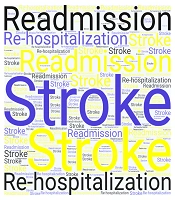The readmission of stroke patients remains a persistent issue, even with advancements in medical care, with reports indicating that the frequency of readmissions within the first year ranges from 31% to 56.1% (1). This high rate is a significant concern for both patients and healthcare providers, as the cycle of discharge followed by unplanned readmission not only impedes recovery but also places additional strain on the healthcare system. Although this issue has garnered attention from researchers, resulting in numerous quantitative and review studies, significant gaps remain in understanding how to effectively reduce stroke readmissions (2, 3). Some studies contain errors in estimating the odds ratios of risk factors, which complicates the application of their findings (4). Furthermore, efforts to develop reliable discharge planning for readmissions have largely been unsuccessful (5). The heterogeneity among studies regarding associated factors is notably high, with inconsistent findings related to age, gender, socioeconomic status, and comorbidities (2, 3). This variability underscores the need for more standardized research methodologies and comprehensive approaches to identify and address the multifaceted factors influencing stroke readmission rates.
Most studies are quantitatively designed and predominantly focus on clinical risk factors, such as cardiac diseases, renal diseases, infections, and comorbidities including hypertension, diabetes mellitus, and atrial fibrillation (5-10). Unfortunately, the social and cultural contexts of patients, such as their family support systems and community resources, as well as broader aspects of healthcare access and socioeconomic status, have not been adequately addressed in stroke recovery research. For instance, studies have shown that lower socioeconomic status and lack of social support significantly correlate with higher readmission rates (11, 12). As a result, the recommendations and discharge programs developed for these patients have often been impractical and ineffective, potentially explaining why 48% of patients fail to adhere to their discharge and treatment plans (13-15).
Much of the education provided to patients is confusing, vague, or impractical (16). This is because patient context and sociodemographic variables—such as education level, economic status, and insurance coverage—are frequently overlooked (17, 18). Without considering these factors, it is unrealistic to expect significant improvements in the readmission rates of stroke patients. Intervention programs, such as tailored rehabilitation services and personalized discharge planning, will only become more effective when all factors influencing stroke readmission, including patients' living conditions and access to follow-up care, are taken into account, and when these programs are customized to the specific sociodemographic characteristics of patients, such as age, ethnicity, and income level (19, 20).
To address the research gap in this field, it is crucial to incorporate qualitative studies that explore the lived experiences of stroke patients in their real-world contexts. Such studies can provide insights into the social determinants of health that contribute to readmission (21, 22). Additionally, recent studies have suggested policy strategies, such as implementing community-based support systems and enhancing patient education tailored to individual needs, which may help reduce readmission rates (23, 24).
While qualitative studies may have limitations, such as issues with generalizability, their results can be combined with quantitative findings to create comprehensive models or conceptual frameworks. These insights can guide the development of interventions and prevention programs aimed at reducing stroke-related readmissions, ultimately lowering morbidity, mortality, and associated healthcare costs.
